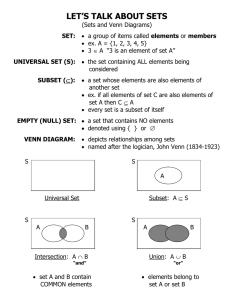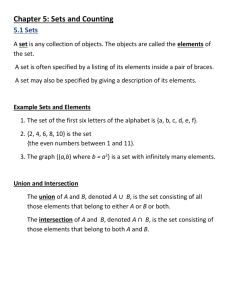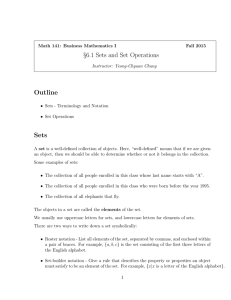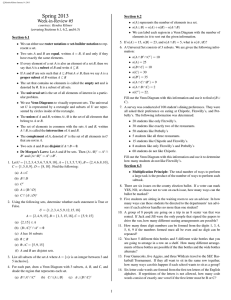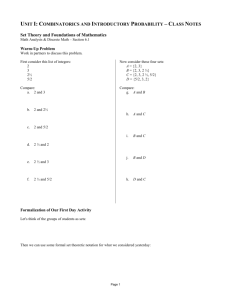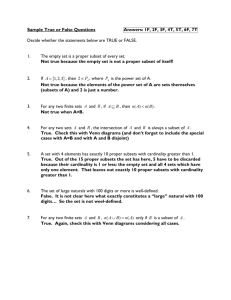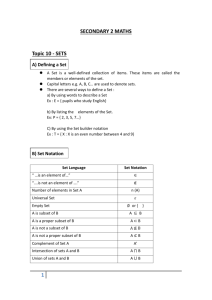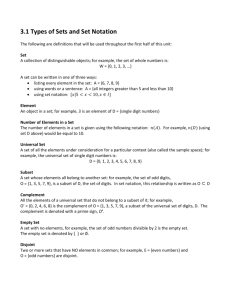Sets and Subsets: Definitions, Operations, and Examples
advertisement
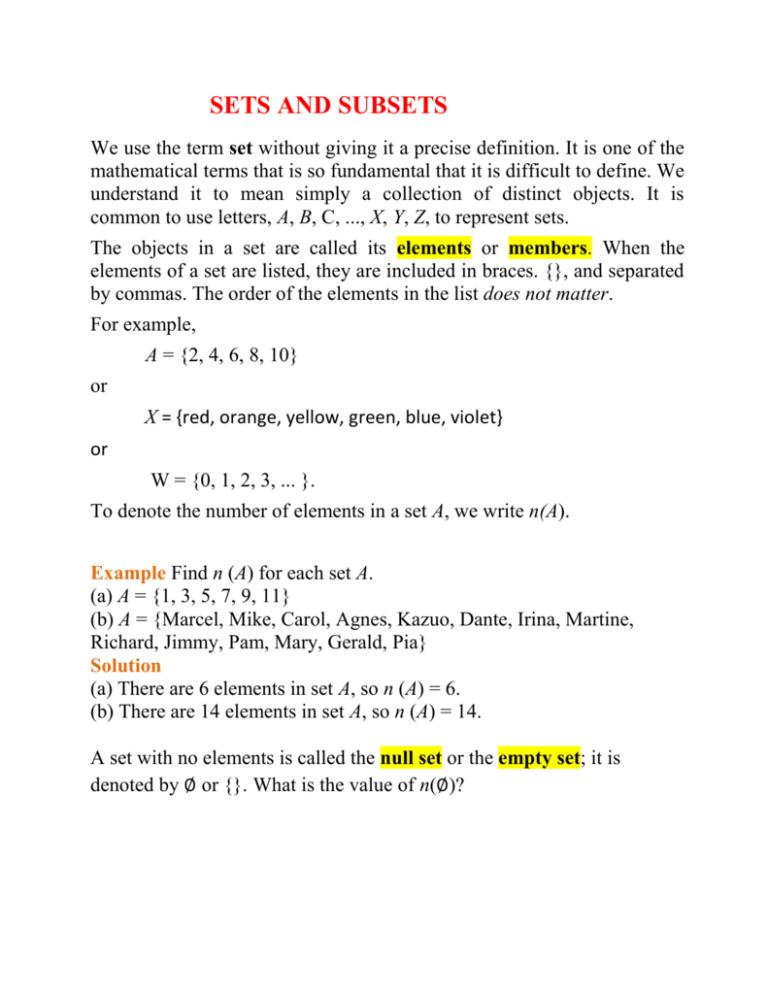
SETS AND SUBSETS
We use the term set without giving it a precise definition. It is one of the
mathematical terms that is so fundamental that it is difficult to define. We
understand it to mean simply a collection of distinct objects. It is
common to use letters, A, B, C, ..., X, Y, Z, to represent sets.
The objects in a set are called its elements or members. When the
elements of a set are listed, they are included in braces. {}, and separated
by commas. The order of the elements in the list does not matter.
For example,
A = {2, 4, 6, 8, 10}
or
X = {red, orange, yellow, green, blue, violet}
or
W = {0, 1, 2, 3, ... }.
To denote the number of elements in a set A, we write n(A).
Example Find n (A) for each set A.
(a) A = {1, 3, 5, 7, 9, 11}
(b) A = {Marcel, Mike, Carol, Agnes, Kazuo, Dante, Irina, Martine,
Richard, Jimmy, Pam, Mary, Gerald, Pia}
Solution
(a) There are 6 elements in set A, so n (A) = 6.
(b) There are 14 elements in set A, so n (A) = 14.
A set with no elements is called the null set or the empty set; it is
denoted by ∅ or {}. What is the value of n(∅)?
A set may be related to another set in a variety of different ways. If two
sets have no elements in common, they are called disjoit sets. For
example, the set of horses in the barn and the set of cars in the parking
garage are disjoint sets.
If all the elements of set B are also elements of set A, we say that set
B is a subset of set A and write B ⊆ A, saying B is contained in A or
A contains B.
According to this, every set is a subset of itself and the null set is a subset
of every set. If B ⊆ A and B ≠ A, then B is a proper subset of A and we
write B ⊂ A.
Example Describe the relationship between the sets described, using the
terms equal, disjoint, subset.
(a) ℕ = the set of natural numbers, 𝐖 = the set of whole numbers
(b) R = the set of colours in a rainbow, B = {grey, black, brown}
(c) D = the set of prime divisors of 34, E = {2, 17}
Solution
(a) Because the natural numbers are also whole numbers, ℕ is a subset
of W, that is ℕ ⊆ W.
(b) Because the colours grey, black, and brown are not colours found in a
rainbow, the sets R and B are disjoint.
(c) Because the prime divisors of the numbers 34 are exactly 2 and 17,
the D and E are equal, D = E.
All sets in which we are interested, in a particular situation, are subsets of
the universal set for that situation. We will denote the universal set by S.
For example, in considering divisors of a natural number we are
concerned only with natural numbers. The universal set in this situation is
ℕ.
Relationships between sets and their subsets can be illustrated using
Venn diagrams. In such a diagram we use a rectangle to represent the
universal set and closed curves, usually circles, to represent the sets in
which we are interested. Venn diagrams are used only for illustration and
not for proof statements about sets.
Example Represent relationships between the indicated sets using Venn
diagrams.
S, the universal set, is the set of integers.
𝐖 is the set of whole numbers.
ℕ is the set of natural numbers.
Solution
Because W contains every natural number as well as 0, ℕ is a proper
subset of W.
Note: Venn diagrams are not meant to give information about relative
sizes of the sets. Also n (W) – n (ℕ) = 1, this is not reflected in the Venn
diagram.
From existing sets it is possible to construct new sets within the universal
set in various ways. Ina venn diagram these new sets are indicate by a
shaded area.
For a set A, the complement of A is the set, denoted 𝑨′, containing
all the elements of the universal set which are not elements of A.
For two sets A and B, the union of A and B is the set, denoted
A ∪ B, containing all the elements of the universal set which
are either in the set A or in the set B or in both sets.
A∪B
For two sets A and B, the intersection of A and B is the set,
denoted A ∩ B, containing all the elements of the universal set
which are both in the set A and in the set B.
Example For the given sets A, B and S, find 𝐴′ , 𝐵′ , 𝐴 ∪ 𝐵, and 𝐴 ∩ 𝐵.
S is the set of positive integers less than 20
A = {4, 5, 6, 7, 8}
B is the set of prime numbers in S
Solution
𝐴′ = {1, 2, 3, 9, 10, 11, 12, 13, 14, 15, 16, 17, 18, 19
B = {2, 3, 5, 7, 11, 13, 17, 19} ⇒
𝐵′ = {1, 4, 6, 8, 9, 10, 12, 14, 15, 16, 18}
𝐴 ∪ 𝐵 = {2, 3, 4, 5, 6, 7, 8, 11, 13, 17, 19}
𝐴 ∩ 𝐵 = {5, 7}
Example For the given sets A, B and S, find 𝐴′ , 𝐵′ , 𝐴 ∪ 𝐵, and 𝐴 ∩ 𝐵.
S is the set of face cards in a deck of cards
A is the set of black cards in S
B is the set of kings in S
Solution
𝐴′ is the set of red face cards
𝐵′ is the set of Jacks and queens
𝐴 ∪ 𝐵 includes all black face cards as well as all kings, so
𝐴 ∩ 𝐵 includes only cards which are both black and king, so
